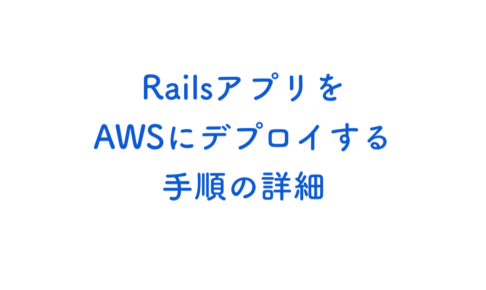おだやんです。
前回は(概要)RailsアプリをAWSにデプロイする大まかな流れを書きましたが、今回はその詳しい手順を出来るだけ詳細にまとめました。
こちらもあくまで備忘録なのでこの通りやってエラーが出ても責任は負えませんので悪しからず・・
環境
Ruby 2.6.0
Rails 5.2.0
Capistrano 3.11.0
AWS linux
Nginx
Unicorn
目次
1・Rails newの前に・・
まずは
$ mkdir [app_name]
$ cd [app_name]
$ bundle init
Writing new Gemfile to /path/to/project_name/Gemfile
作成されたGemgileを編集。
# frozen_string_literal: true
source "https://rubygems.org"
git_source(:github) {|repo_name| "https://github.com/#{repo_name}" }
gem "rails"
railsをインストール。
$ bundle install --path vendor/bundle
2・Railsプロジェクトを作る
$ bundle exec rails new . -B -d mysql --skip-turbolinks --skip-test
そしてGemのインストール
# frozen_string_literal: true
source "https://rubygems.org"
git_source(:github) {|repo_name| "https://github.com/#{repo_name}" }
ruby '2.6.0'
gem 'rails', '5.2.0'
gem 'mysql2', '>= 0.4.4', '< 0.6.0'
gem 'puma', '~> 3.11'
gem 'bcrypt', '~> 3.1.7'
gem 'sass-rails', '~> 5.0'
gem 'uglifier', '>= 1.3.0'
gem 'coffee-rails', '~> 4.2'
gem 'turbolinks', '~> 5'
gem 'jbuilder', '~> 2.5'
gem 'devise'
gem "omniauth"
gem 'omniauth-twitter'
gem 'omniauth-facebook'
gem 'omniauth-google-oauth2'
gem 'kaminari', '~> 0.17.0'
gem 'jquery-ui-rails'
gem 'jquery-rails'
gem 'materialize-sass'
gem 'mini_racer'
gem 'bootstrap-sass'
gem "font-awesome-rails"
gem 'carrierwave'
gem 'mini_magick'
gem 'bootsnap', '>= 1.1.0', require: false
gem 'capistrano'
gem 'capistrano-rails'
gem 'capistrano-bundler'
gem 'capistrano-rbenv'
group :development, :test do
gem 'byebug', platforms: [:mri, :mingw, :x64_mingw]
gem 'pry-rails'
gem 'pry-byebug'
gem 'pry-doc'
gem 'rspec-rails'
gem 'factory_bot_rails'
gem 'rails-controller-testing'
gem 'hirb'
gem 'hirb-unicode'
# gem 'capistrano3-unicorn'
end
group :development do
gem 'web-console', '>= 3.3.0'
gem 'listen', '>= 3.0.5', '< 3.2'
gem 'spring'
gem 'spring-watcher-listen', '~> 2.0.0'
gem 'better_errors'
gem 'binding_of_caller'
gem 'sqlite3'
end
group :test do
gem 'capybara', '>= 2.15'
gem 'selenium-webdriver'
gem 'chromedriver-helper'
end
# Windows does not include zoneinfo files, so bundle the tzinfo-data gem
gem 'tzinfo-data', platforms: [:mingw, :mswin, :x64_mingw, :jruby]
group :production, :staging do
gem 'unicorn'
gem 'rails_12factor', '0.0.2'
end
不要なGemがいくつかある気がする。
3・ローカル環境とGitとの連携
gitと連携させる。まずはGithubにてアカウント作成。
$ git init
$ git add .
$ git commit -m "first commit"
https://github.com/ でレポジトリ作成。リポジトリ上に表示されるhttpsから始まるURLをコピー。
$ git remote add origin https://github.com/username/****.git(githubからコピー)
$ git push -u origin master
これでとりあえずはpushできるようになった。
gitとssh接続できるように公開鍵・秘密鍵を設定する。
$cd ~/.ssh
$ssh-keygen -t rsa
$ ssh-keygen -t rsa
Generating public/private rsa key pair.
Enter file in which to save the key (/Users/(username)/.ssh/id_rsa):
Enter passphrase (empty for no passphrase):
Enter same passphrase again:
生成された公開鍵をgithubに登録。
そして
$vim ~/.ssh/config
でssh接続設定を行う。
Host github
user git
Hostname github.com
Port 22
IdentityFile ~/.ssh/id_rsa
これで接続テスト。
&ssh -T github
次にpush時に毎回URLを書かなくていいようにURLを登録する。
git remote add origin [git@github.com:Username/app_name***.git]
これで
git add .
git commit -m"second commit"
git push [remote-name] [branch-name]
でpushされるはず。初回は$git push origin masterでいいが、次回以降の開発ではBranchを切ってそこにpushする。
どんなURLが登録されているのか確認したいときは下記コマンド。
$git remote -v
4・EC2(AWS)設定
まずはEC2の設定。※ルートユーザーでなくIAMユーザーとして操作する。
・大まかな流れはこちらの記事を参考にします。
・詳細はこちらの記事を参考にさせていただきます。
【4-1・ネットワーク環境設定】
・VPCの作成
・サブネット
・インターネットゲートウェイ
・サブネットとルートテーブルの関連付け
・セキュリティグループの作成
【4-2・RDS設定】
・サブネットグループの作成
・DBインスタンスの作成
【4-3・AWSにてEC2設定】
・インスタンスの作成
・Elastic IPの割り当て
・インスタンスにSSHでログイン
【4-4・サーバーの環境構築】
・Nginxの設定
・管理ユーザーの作成
・ドキュメントルート領域を作成
・プラグインのインストール
・MySQLをセットアップ
・パラメータグループを作成
【4-5・Railsアプリのデプロイ】
・GitHubとEC2の連携
・アプリケーション格納用の領域を作成
・GitHubからRailsアプリをクローン
・nginxの設定
・Unicornの設定
【4-6・ロードバランサー(AWS)の設定】
【4-7・アプリ起動】
5・独自ドメインを紐付ける
5-1・お名前.comで独自ドメインを取得
5-2・Route53(AWS)にて設定
5-3・お名前.comにてネームサーバー変更
Route53での設定で表示された4つのネームサーバーをお名前.comに転記。
5-4・ネームサーバーの確認
下記コマンドでネームサーバーが設定されてるか確認できる。
$nslookup
続いて下記コマンド入力。
> set type=ns
> ドメイン名
~~~~以下のように出たらOK~~~~
Server: 10.0.0.2
Address: 10.0.0.2#53
Non-authoritative answer:
christchurches-map.com nameserver = ns-1520.awsdns-62.org.
christchurches-map.com nameserver = ns-1643.awsdns-13.co.uk.
christchurches-map.com nameserver = ns-193.awsdns-24.com.
christchurches-map.com nameserver = ns-517.awsdns-00.net.
5-5・ドメイン適用
Route53にてCreate Record Setを作成する。
5-6・サーバーでNginx設定
$ sudo vi /etc/nginx/conf.d/アプリケーション名.conf
~~~~アプリケーション名.conf~~~~
変更前
server {
listen 80;
client_max_body_size 4G;
server_name 52.192.101.190;
変更後
server {
listen 80;
client_max_body_size 4G;
server_name www.christchurches-map.com;
5-7・Unicornのプロセスをkill
$ cd /var/www/projects/christchurches-map/
#Unicornの起動確認
$ ps -ef | grep unicorn | grep -v grep
$kill 番号
5-8・Nginx&Unicorn再起動
$ sudo service nginx restart
その後Unicornも再起動。
ドメインにアクセスしてアプリが表示されるか確認。
6・ssl(https)接続設定を行う
6-1・AWSのCertificate Managerで各種設定
設定を行いリクエストを送信。届いたメールを承認する。
6-2・EC2にて設定
EC2→ロードバランサー→リスナーを編集しhttpをhttpsに変更。
次の画面でACMの既存の証明書(CMで発行したもの)をチェック。
保存する。
6-3・Route53にて設定
Hosted Zone→対象ドメインを選んでGo to Record Setsへ。
Type:Aドメインを選択してAliasをYesに。
TargetにELBを選ぶ。
6-4・Nginx(サーバー側)の設定
何かをどうにかする。(調査中)
6-5・ローカルにて
config/environments/production.rbを編集。
#下記行のコメントアウト外す
config.force_ssl = true
6-6・もろもろ再起動
Unicornのプロセスkillして、Nginx再起動&Unicorn再起動
6-7・ブラウザからドメインにアクセス
以上です。
大まかな流れが知りたい方はこちら。
下記記事を参考にしました。




















コメントを残す